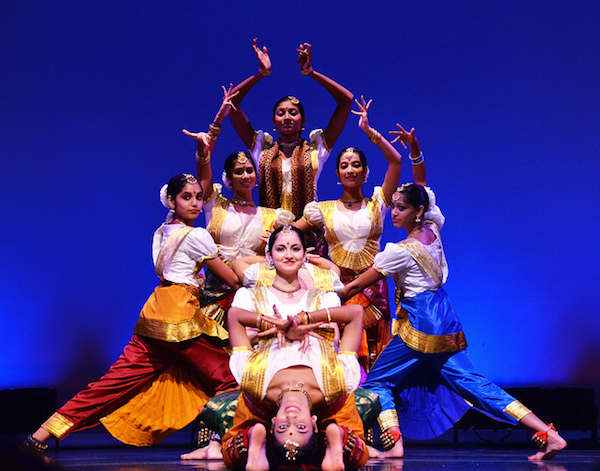
Arts Challenge winner Ranjana Warier bridges cultures with dance
By Fernando González, South Florida-based arts and culture writer
Living in South Florida means crossing invisible borders every day, many times a day. Almost inevitably, at one time or another, we are all visitors in someone else’s traditions, have to learn a different code, be it in business or our personal lives, or find a common language.
It is both enriching and a challenge.
It has also inspired Ranjana Warier, who was born in India, to become a facilitator.
A senior security systems engineer for Miami-Dade County by day, Warier is also an Indian classical dancer, choreographer and teacher — with a passion for “demystifying” such rich tradition for new audiences unfamiliar with its history and aesthetics.
“As a teacher, I really wanted to keep everything very traditional,” she says. “But I also want to explore and push the boundaries. Indian classical dancing is somewhat complex to someone looking from the outside. There are a lot of gestures, a lot of technique. Using non-traditional themes always help to create that interest from people who don’t know or don’t understand Indian mythology.”
Warier, is the artistic director of Rhythms School of Dance in Davie. The school, which opened in 2004, offers certification in Indian classical dance through an affiliate program with Alagappa Performing Arts Academy in Escondido, Calif.
“I worked with the town of Davie, offered classes, and it was the beginning of going out [of] the traditional box and looking for other cultures,” she says. “It also helped me to look at [Indian classical dance] differently. I’ve always looked at it from the inside; this helped me to step out and look at it from the outside.”
Her efforts since then include productions such as “Festivals of India” (2010), “Once Upon a Time: An Adaptation of Western Fairy Tales Through Indian Dances” (2012), and “From Bharatanatyam to Bollywood: The Journey of Indian Dance” (2013).
In 2012, she won her first Knight Arts Challenge “to promote cross-cultural understanding by showcasing Indian classical dances through adaptations of Western fairy tales.” In collaboration with five Indian dance schools in Florida, Warier turned “Sleeping Beauty” into “Anvita.”
Last year, Warier won her second Knight Arts Challenge, this time for setting the work of Miami poet Adrian Castro, often written to Afro-Caribbean rhythms, to traditional Indian dance.
“It’s like a visualization of the poetry by Adrian Castro in Indian dance,” she explains. “We are in the preliminary stages, the planning.”
The Center for Writing and Literature at Miami Dade College is a partner in the project. “They will be facilitating the administrative work and also [will] create and maintain a website, to include artistic statements, photography, poetry, educational information … which will allow a deeper understanding of the project,” Warier says.
Finding the rhythms
Castro’s poetry draws not only from the meanings of the words but also their sounds as well as the rhythms of speech and Afro-Caribbean music, all intriguing points of departure for a choreographer.
“Right now we are approaching it from meaning rather than rhythm,” says Castro. “The poems I’ve given Ranjana are not necessarily the most rhythmic poems I have. They have to do with spirituality. They also have to do with the elements: earth, water, fire and air. They are all part of the African spirituality, but also traditional Hindu religion.”
Castro has worked before in cross-cultural projects involving music and poetry, most notably “Furacan Caribe” (2000), a piece by experimental Austrian composer Lukas Ligeti featuring musicians from Cuba, Haiti, Trinidad and Puerto Rico.
Warier hasn’t decided if Castro will appear on stage as part of the performance.
“I can be — but I don’t have to be,” says Castro. “It might be a more formal reading, like standing at a lectern, or interacting with dancers. I’ve shown her videos of rumba, and rumba is a conversation between the drummers. Whatever Ranjana feels is best.”
The project will premiere in April, during National Poetry Month.
Connections between cultures
Born in Kerala, a state in southwest India, Warier was introduced to Indian classical dance when she was 6, and later trained in Bharathanatyam and Mohiniyaattam, both classic styles from southern India.
“I was born and brought up in an art-loving family so I started learning dance when I was very little, and I was very fortunate to have been trained by some of the very best teachers in India,” she says. “But none of us ever thought I’d become a dancer. It was one of those things you did. Everyone in the family took some kind of [art discipline], either dance or a musical instrument or singing. It was part of the upbringing. “
After graduating from college in India with an engineering degree, in 1990 Warier came to Florida International University to pursue a master’s degree in computer science. She settled in South Florida, “kept in touch with [the dancing] and started teaching.”
“There’s a lot of my personal interest in this work,” she says. “In South Florida we are lucky to be exposed to so many world cultures and, in many ways, I relate that to India which is a country-within-a-country, with different languages and cultures, like a melting pot.”
“The interesting thing to me is that a lot of [cultures] look so different from outside, but when you delve a little deeper into them, you find a lot of similarities, a lot of connections,” adds Warier. “In a lot of our communities we work among ourselves and when we do that we tend to create a little bit of [an] island. Building bridges is very rewarding.”
Do you have an idea for building bridges through the arts? Knight Arts Challenge South Florida is open for entries through Feb. 23. Apply at knightarts.org.
Recent Content
-
Artsarticle ·
-
Artsarticle ·
-
Artsarticle ·

